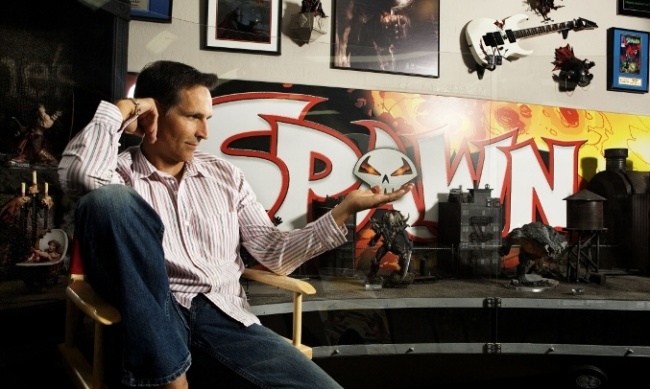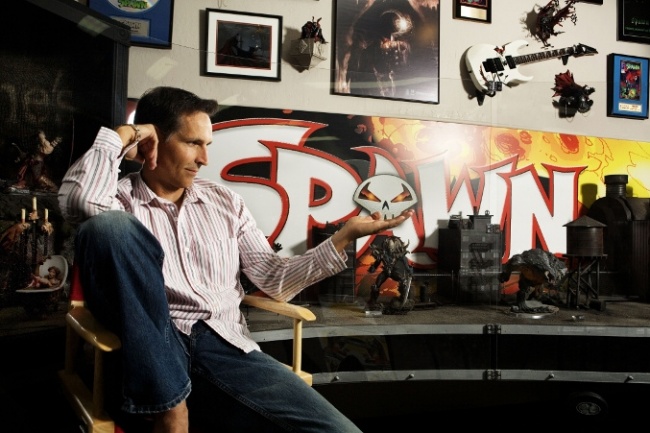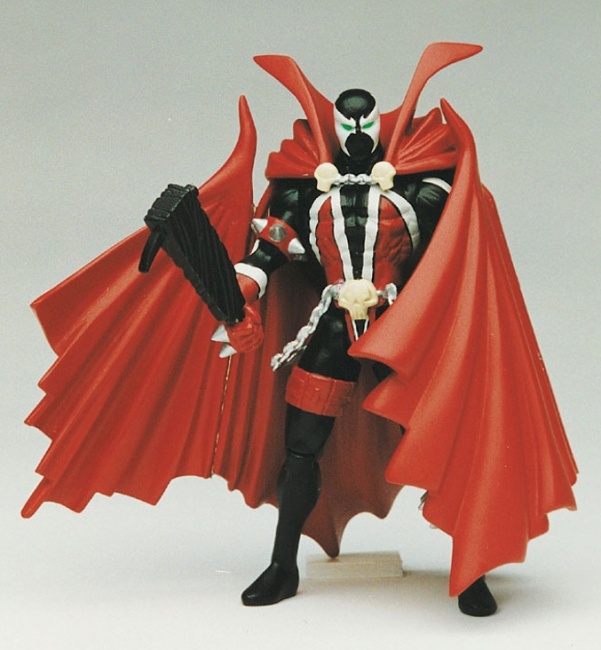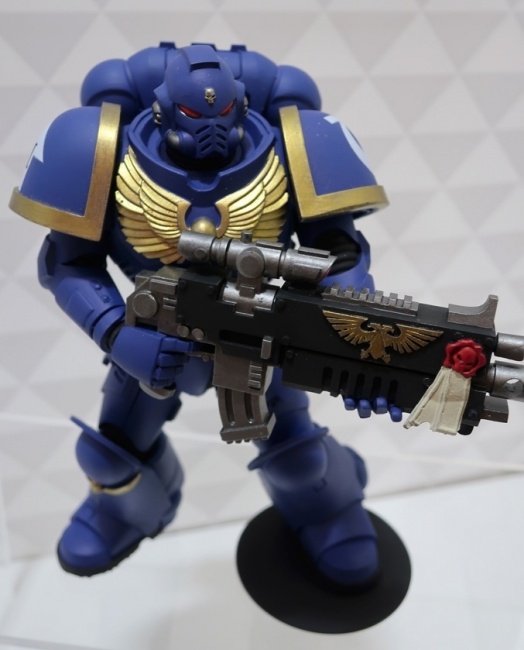We got a chance to sit down with McFarlane Toys CEO and Image Comics partner Todd McFarlane at Toy Fair. In Part 1 of this two-part interview, we talk about the beginnings of McFarlane Toys, how the toy business has evolved over the years, and the key products from the company’s 2020 line (see "Preview: McFarlane Toys at NY Toy Fair"). In Part 2, we talked about achieving the landmark 300th issue of his title Spawn, his thoughts on the current state of the comics business, repeated #1s vs. long runs, the growth of graphic novels, the future of comics, the Spawn movie, and the future of the Spawn comic.
ICv2: We’re at Toy Fair, so maybe we can start out talking about your toy business. How long ago did you found McFarlane Toys?
Todd McFarlane: My first show was 1995. Our toys came out shortly thereafter. This will be our 25th year. It was a little five‑by‑five‑foot booth, and I didn't even have a prototype.
A Toys R Us buyer came along. He had an assistant. The assistant was a comic geek. He said, "Hey, boss. This is the guy I was telling you about." At that point, Spawn was at the top of the charts (remember when we first started). He went store-wide with Spawn. It was easy then to walk into Walmart and say, "Hey, your competitor's got this." They bought it.
Then the dominos started. Then, you go, "Hey, let's get some more licenses." We've been going ever since.
What are your reflections on where the toy business is now, compared to when you started?
I got into it because of the art. In all honesty, the company was started because I going, "I don't understand why they can't make these things look cooler." Action figures, specifically. Why couldn't they be cooler? It's just sculpting. It's clay. Clay will go into any shape you want. I couldn't understand it. So, I eventually asked somebody, "How do you make toys? Why don't we try some?"
I remember going to that first Toy Fair, I guess it was '95, and walking around I got to go into the Hasbro and Mattel, because they had their own buildings back then. It was different. It wasn't in the Javits Center, they used to have their own buildings. We had these smaller buildings that you had different people that either owned a floor or big offices or whatever else. Like I said, we were on one floor in one office in 1/40th space of that one office.
When I walked around, and I looked at what was out there, at least in the action figure aisle, there's maybe two figures that I looked at that I went, "Those are cool." Now, fast forward 20 years later, shoot, I walk around and there are hundreds and hundreds. You see some of them at the San Diego con. There are hundreds of hundreds of figures I go, "Wow. That's good. Oh my god, that's good. Oh my god."
The winner has been the consumer, I think. Hopefully, we had something to do with leading the blueprint of just saying, if you make a better product, then I think people will respond to it, if you make something a little more sophisticated. By the way, you can even up‑charge if you need to.
To me, it's the quality of the product has gotten better. Although, with that said, there's this point where there's a big resistance across the $10 mark. For years, everybody had $9.99, $9.99, $9.99. Then eventually, we couldn't hold it. Everybody couldn't hold it. I let Hasbro and Mattel break that number before I did. Then it seemed like we zoomed to $15, $20 real fast. After holding $9 for so long, $9.99, we zoomed to $20.
The problem now is because raw materials are going up and the cost of labor is going up, that I'm starting to see just a little bit of a pull-back now in some of the big companies, of doing some of the tricks that they were doing 20 years ago to save a nickel, that to me eats away at the quality of the product to the consumer. Which is good, for me, because I go, "I'm not. I'm not going to make those same cuts." If you want to make your toys look duller, then go ahead. I'll continue to do what I'm doing.
One of the things we were excited about, and they were excited over at the Games Workshop booth also, is the Warhammer stuff McFarlane is making. You get to paint your own figure product, which is kind of cool. That's a first, right?
Yeah, because I remember looking at Warhammer toys going, "They're small. They're twice as much as my plastic toy. You have to assemble them, consumer, and you have to paint them, consumer."
What are you doing wrong, right?
I'm in the wrong business here, right. Oh my gosh.
Yeah, we're going to try it, and see if it has the same appeal. If it does, then obviously the Warhammer brand has literally hundreds if not thousands of different characters that we can go at.
I've always liked those types of brands, where if you do strike a chord there's a way to keep them going for literally years, and years, and years, because of the depth of characters. It's so deep, and it's not like it revolves around the same two or three. You're not saying, "Hey, OK, we've got Batman and Robin and Superman." How much more can you go?
To me, I think there's a cool factor with Warhammer, just like my toys. If it looks cool, it's not going to matter whether they bought the game or whatever. It's just going to be Warhammer is going to drive it.
So, we'll see. We'll see if there's a market for it.
In terms of your 2020 releases, what's the item or items that you're most excited about?
I would say it's probably a handful of the upcoming DC Multiverse, and more specifically the ones that are a little more stylized, that are a little bit out of the norm of what you're used to seeing.
Our first couple of waves came out, and there's a lot of them in there that, to me, I would put more into the classic look. But it's still Superman. I try to do the best I can, but it's still Superman, and there's not anything different I can add to it.
But we also, at the same time, did this toy that's Superman in armor. I think that character's design has been in five panels, one book, five panels. So, it's not like it's a popular comic book character. But it looks like a toy. When I saw it, I go, man, that looks like a toy. I go, let me just bend the visuals of this thing a little bit, so it's going to sit on that shelf really good. That one and the Hellbat that have the big wings, and Batman in the armor, both of those are sell-outs right now.
Even stuff like the Batman Who Laughs. I don't know that a mom's going to bring that home to her eight-year-old kid. We did a build-up. It was a vehicle instead of a figure, and you only had to buy three instead of six.
I'm just trying these experiments, trying to see what's working. There's a couple of them that seem to be a solid double if not a triple, that I go, "Wow." For me, that's interesting data, because there's hundreds of possibilities behind those ideas that exist in the library of the DC Multiverse that I can now exploit, and not have to worry that it's the most popular characters.
I can veer down the groove that I'm very good at, which is just cool at a fair price. High quality, cool stuff at a fair price. That sells, that sells. By the way, piece number four, give them a lot of plastic at the same time. You can always sell.
How does your toy business break down in terms of mass channel versus comic stores?
Our biggest account currently is Amazon. Bigger than Walmart, Target right now.
When did that happen?
Just recently. Part of the reason is because they're willing to put up almost anything we make. So, when you add up the dribs and drabs of 100 items, the totality of that business is a lot. Where in the model of having to put something on a peg and making it move off the shelf, the big box stores aren't going to take all 100, because they're not all created equal.
Like Walmart goes, "I don't care if I sell 10 of that." But that's still 10. 10 is better than 0. The big stores can't think in those terms. So, just through attrition, I've been able to add everything there.
Does Amazon price aggressively?
Yeah, they're competitive. The comic book stores, they do OK. I mean, they're not a huge business. I think part of it is because I'm not making a lot of exclusive stuff for them, per se. They know that they're not going to be able to compete price-wise with the big stores, so they don't even try, which is why they like stuff that's aimed a little bit more exclusive to what they're doing.
Are you doing any comic book store exclusives?
We talk about it from time to time with Diamond, and they give us their suggestions. We'll probably try to sneak something here or there. Sometimes it's just repackaging or repainting something, so it's easy. Because their MOQ, their minimum quantity of the buy, it's not nearly as high.
Because often, we've said, hey, we'll give you this as an exclusive, but here's the number. The number is palatable to the big store and the Fortune 500 companies, but you can imagine that the comic book stores can't quite swallow that amount.
Click here to got to Part 2.

McFarlane Toys from the Beginning, the Evolution of the Toy Business, Top 2020 Products
Posted by Milton Griepp on March 10, 2020 @ 5:05 am CT





